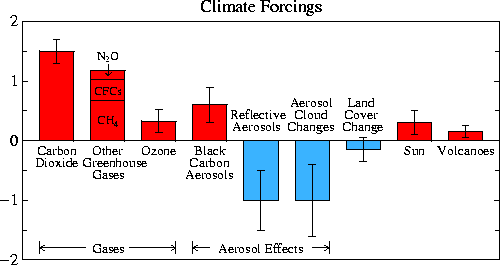And while we're on the subject, what about all those different forms of stored methane in nature? You've got your methane clathrates, methane hydrates, methane locked in permafrost, methane bubbling up from the tropics – I mean, what the hell?
I wish I could say everything clears up when you learn a little bit about methane. Unfortunately, it's not that kind of subject. Questions lead to other questions, like: why did methane concentrations double in the industrial age, level off for ten years, and then start rising rapidly again three years ago? (See: http://www.treehugger.com/20090306-methane-concentrations.jpg.)
Let's start with what methane is up to in the climate today:

We can see that the forcing of methane (CH4) is about half that for carbon dioxide. Why is that, if it is such a powerful greenhouse gas? The answer is that there's a lot less of it. CO2 is measured in parts per million (about 390), and methane is measured in parts per billion (about 1,750). So CO2 is more important because there is more of it.
The other reason we care more about CO2, and the reason you hear such different numbers for how much more "potent" methane is relative to CO2, is that CO2 hangs around in the atmosphere basically forever (hundreds to thousands of years) and methane breaks down quickly (about a dozen years). So the big numbers (400 times more powerful) refer to a molecule of CH4 vs a molecule of CO2, and the smaller numbers (25 times, 50 times) refer to the fact that CO2 is weaker as a GHG, but hangs around a lot longer.
This matters quite a bit, because of feedbacks. Positive feedbacks (things like loss of the sea ice in the Arctic, leading to a change in albedo and more warming, or warming of the oceans, leading to a reduced ability to store dissolved CO2, more atmospheric CO2, and more warming) mean that front-loaded warming is more dangerous than "slow and steady" warming, even leaving aside the fact that warming sooner rather than later leaves less time for adaptation. If warming today triggers more warming (and it seems very likely that is does) then warming from methane follows those rules of compound interest earnest financial planners try to teach you: warming now (like saving now) leads to bigger results, because it triggers positive feedback (the "interest") which causes warming, which leads to more feedback, which leads to more warming (the interest earns interest; this is the "compound" part.) So a spike in methane levels could be very dangerous; by giving the climate a hard shove for the 12 years or so it is in the atmosphere, methane can set in motion processes that will be warming the climate after the initial bolus of methane is long gone.
Should we be concerned about the possibility of such a spike? Unfortunately, yes. To understand why, we have to delve in to the different forms of stored methane and how they become unstored. I'll explore that in part two.
No comments:
Post a Comment